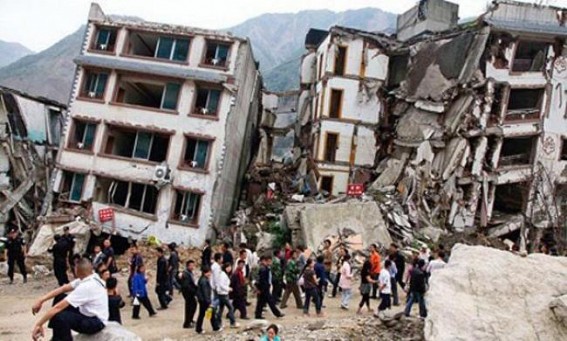Ramesh Singh

PHOTO : Nepal Earthquake. TIWN / IANS Photo
A big earthquake in Assam and in the Himalayan region was expected ever since I was a geophysics student at Banaras Hindu University during 1974-1976. At that time, funding agencies spent money for routine observations of various parameters in the wake of a major earthquake. In the past, a few major earthquakes have occurred in the Himalayan region: the Bihar-Nepal earthquake of In 1988, Uttarkashi in 1991 and Chamoli in 1999.
They claimed many lives and many houses collapsed, especially during the Uttarkashi quake. The major damage to buildings occurred because of the poor quality of construction.
In the last three decades the population has increased and the density of buildings has also increased in the Indo-Gangetic plain; many high rise buildings have mushroomed in many cities in this area.
In earthquakes, building collapses claim human lives. Some of the major cities in the Indo-Gangetic plain are connected underground upto Himalayan region. If any major earthquake occurs in the Himalayan region, the energy will be transmitted to major cities - especially Delhi and the surrounding. Can all the houses and highrises sustain the ground acceleration generated by any earthquake? Taking the lead in this, IIT-Kanpur emphasized, at a series of conferences and workshops during 1988-2007, that building codes must be strictly followed in. But in India, it is difficult to follow these building codes and most of the buildings are built these only on the paper.
In India, we have the National Disaster Management Authority (NDMA), whose chairman is the prime minister. During the earlier Congress regime, scientists were involved and now Narendra Modi has been criticized for remove many scientific members and administrators. I must appreciate Mr. Modi’s action and his vision as some of the members were enjoying their positions without doing anything and never ever participated or visited any areas prone to natural hazards.
I would urge Mr. Modi to launch an outreach programme on TV to warn people living in the Himalayan and Indo-Gangetic plain areas to make their buildings safe by following proper building codes and even educate poor people how to make a cheap and safe buildings so that human lives can be saved if an earthquake occurs. We must also educate school students about the different kind of natural hazards and their impact and how to save themselves.
Earthquake prediction is a big challenge before scientists and it is difficult to expect any early warning. Scientists must be involved in understanding earthquake processes and develop building codes for different regions. The Ministry of Earth Sciences may consider enhancing the GPS network in the Himalayan region at intervals of 50-100 km. Overall, NDMA must study how to implement building codes to design earthquake proof buildings since a big earthquake may occur tomorrow or in a week or in s month or in a year.
We should not forget 1923 Tokyo earthquake of 7.9 magnitude, which killed more than 148,000 people, with 50,000 going missing and thousands of buildings collapsing. These days, buildings are generally intact with the same magnitude earthquake in Japan since building codes are strictly followed.
Ramesh Singh, formerly with the IIT-Kanpur is currently Professor with the School of Earth and Environmental Sciences, Chapman University, Orange County, California and is President Elect of the Natural Hazards Focus Group of the American Geophysical Union.
To send your appreciation and comments pl. send email to editor@tripurainfoway.com or tripurainfoway@gmail.com or post online below.
- Why Modi’s BJP swept key India regional elections
- TIWN’s landmark legal victory against BJP Govt’s Illegal attacks to shutdown fearless Media
- India to be world's third-largest economy by 2030 -S&P Global Ratings
- Tripura's Dark Era : Mafia style Brutal attacks on Journalists, fight for your Citizen rights !
- How to access tripurainfoway.com via HOLA from India



